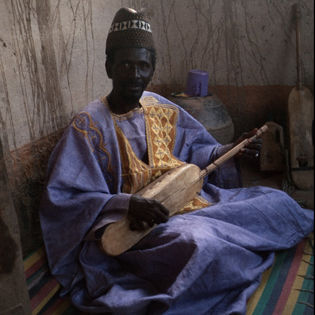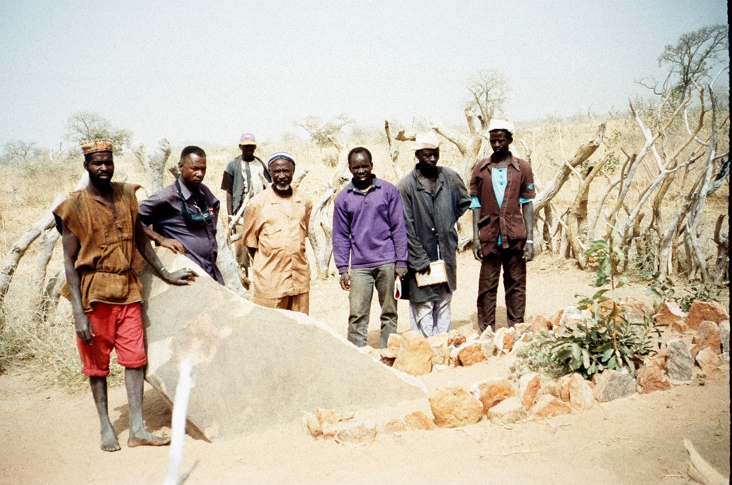Re-thinking Sunjata: epics, oral literature & translation in West Africa
- Location
- Danford Room - Arts Building (2nd Floor)
- Dates
- Friday 10 November 2017 (12:30-18:00)
 Abdoulaye Sako, griot or jèli, (praise-singer) from Diebougou, Mali, with his ngoni photographed at Kamiko, Mali, before performing the Epic of Sumanguru Kante in 1997 [photo copyright Stephen Bulman, 1997]
Abdoulaye Sako, griot or jèli, (praise-singer) from Diebougou, Mali, with his ngoni photographed at Kamiko, Mali, before performing the Epic of Sumanguru Kante in 1997 [photo copyright Stephen Bulman, 1997]
This event is run in conjunction with BRIHC
The Danford Room
Schedule
- 12.30 Welcome lunch
- 13.15 Introduction (Karin Barber)
- 13.25 Commentary (Paulo Fernando de Moraes Farias)
- 13.35 West Africa’s flexible epics: Manding’s oral tools for political commentary, status claims, and socialisation (Stephen Bulman)
- 14.15 The electronic corpora of texts in Manding languages (Valentin Vydrine)
- 14.45 Break
- 14.55 The Blacksmith's Secret: On the Origin of Life by Means of Cultural Expertise (Jan Jansen)
- 15.35 Discussion
- 16.00 Closing remarks (Rebecca Jones)
- 16.05 Tea/coffee
- 16.25 Screening of Soundiata: l’heriter du griot (Dani Kouyate) (94 mins)
- 18.00 (approx.) Close
Speakers
- Stephen Bulman
- Jan Jansen
- Valentin Vydrine
Introduction to the subject and the book
West Africa’s cultures have produced a long tradition of oral heroic epics which relate significant episodes of the region’s history, none more so than the Manding populations of Mali, Guinea and surrounding states, whose legends concerning the heroes Sunjata and Sumanguru have roots stretching back to the middle ages. These epics are still performed today, and act as a rich cultural reservoir of values, norms, concepts and ideals, that help to knit together diverse communities across a vast stretch of West Africa through a shared history of change-leading heroes, powerful sisters and mothers, blacksmiths, praise-singers/intercessors (jèliw or griots), traders, Muslims divines and leading clans.
The Epic of Sumanguru is one such tradition, performed in Mali in 1997 and now presented by the publisher E.J. Brill in the original Bamana text and annotated English translation, together with extracts from the musical accompaniment, a note on the language of the text, and a scholarly introduction that offers insights into the tradition’s rich and complex meanings for its audience, and its value to anthropologists and historians of Africa.
The Epic of Sumanguru Kante contains griot Abdoulaye Sako’s oral narrative [pictured above] of the life of Sumanguru, a familiar figure within Manding epic oral traditions about old Mali, as Sunjata Keita’s arch-adversary, but rarely the subject of an epic of his own. Sako’s performance includes hitherto undocumented episodes relating to Sumanguru’s life and role as the ruler of Soso, the little-known state said to have flourished in the western Sudan between the fall of ancient Ghana and rise of the empire of Mali. The half day seminar will explore the important role of Sumanguru, and of the blacksmith- and power-association-leading heritage he represents, through analysis of the epic, offering new insights into the well-springs of the medieval state of Mali, of Manding epics themselves, and of the roles these epics perform in Manding culture.

Grave of Dabi Ture, mother of Sumanguru Kante, Sosso, Mali, 1997 [photo copyright Stephen Bulman, 1997]
The seminar will discuss the growth of local heritage in Mali and Guinea, linking epic narratives with present-day sites, including the grave of Sumanguru’s mother at Sosso (pictured above), the Sosso Balla of Sumanguru at Niagassola, Guinea, accorded status as part of the ‘Intangible Cultural Heritage of Humanity’ by UNESCO.
The seminar will also examine the important role the memory of Sumanguru has played at Koulikoro, Mali, since at least the 19th century, where the prominent rocky outcrops of Nyanankuru are home to a shrine to his memory, and various legends relating to the hero’s demise, attested in historical records since the 19th century.